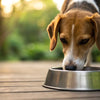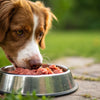What's in Raw Dog Food: Understanding Ingredients for Optimal Canine Health
- Houndsy
Table of Contents
- Introduction
- Understanding Raw Dog Food Components
- The Nutritional Benefits of Raw Dog Food Ingredients
- Different Models of Raw Feeding
- Potential Risks of Raw Dog Food Diet
- Transitioning to a Raw Diet
- Conclusion
Introduction
Imagine your dog bounding through a lush, green field, coat glistening in the sunlight, with a vitality and energy that seems boundless. This joyful image can be influenced profoundly by what they consume—specifically, a raw dog food diet. In recent years, the popularity of raw feeding has surged among pet owners who aim to provide their dogs with the most natural and nutrient-dense diet possible. But what actually goes into raw dog food?
As dedicated dog lovers, understanding the components of our pets' diets is crucial—not just for their health but also for ensuring we’re making informed choices that align with our values on convenience, quality, and functionality. By the end of this post, we’ll uncover the key ingredients in raw dog food, explore their benefits, and assess how they contribute to our dogs’ well-being.
In this blog, we'll cover:
- The basic components of raw dog food
- Nutritional benefits derived from these ingredients
- Different models of raw feeding
- Potential risks involved in raw feeding
- Practical tips for safely implementing a raw food diet
Let’s dive into the essentials of raw dog food and see how this approach may elevate not only our dogs' health but also our feeding rituals.
Understanding Raw Dog Food Components
When we talk about raw dog food, we’re referring to a diet primarily consisting of raw meat, organs, bones, fruits, and vegetables. Unlike conventional kibble, these whole-food ingredients can offer a variety of nutrients that closely mimic what canines would consume in the wild.
Muscle Meat
Muscle meat forms the backbone of raw dog food. It includes cuts from beef, chicken, turkey, and lamb. Muscle meat is replete with protein, which is essential for muscle development, energy, and overall health.
- Benefits: High-quality protein supports strong muscles, helps maintain healthy skin and coat, and contributes to the production of enzymes and hormones.
Organ Meats
Organ meats are powerhouses of nutrition. This category includes liver, kidney, and heart. These parts are often referred to as “offal” and are vital for a balanced raw diet.
- Liver: Rich in vitamin A, iron, and various B vitamins, liver supports vision, immune function, and red blood cell production.
- Kidneys: Known for their detoxification properties, kidneys provide protein, vitamin B, and various minerals.
- Hearts: Packed with taurine and omega fatty acids, hearts contribute to healthy heart function and brain health.
Bones (Raw and Ground)
Bones are an indispensable part of raw dog food and are typically included in two forms: raw meaty bones (RMBs) and ground bones, such as bone meal.
- Raw Meaty Bones: These help promote dental health through chewing, while also providing calcium and phosphorus for bone strength.
- Ground Bones: Bone meal can offer balanced calcium-phosphorus ratios without the risk of choking.
Fruits and Vegetables
While dogs are primarily carnivorous, adding fruits and vegetables can introduce essential vitamins, minerals, and fiber into their diet.
- Beneficial Vegetables: Carrots, broccoli, and spinach are often added for fiber, antioxidants, and vitamins.
- Fruits: Blueberries, apples, and cranberries can enhance hydration, support urinary health, and provide antioxidants.
Fats and Oils
Incorporating healthy fats is crucial for energy and skin health. Common sources include fish oil, flaxseed oil, and rendered fats.
- Omega Fatty Acids: These are essential for maintaining a healthy coat and may help mitigate allergies.
Supplementation: Probiotics and Enzymes
These can be added to aid digestion and help maintain gut health. Probiotics support healthy gut flora, while enzymes assist in nutrient breakdown.
The Nutritional Benefits of Raw Dog Food Ingredients
The right combination of raw dog food ingredients can provide a complete, balanced diet that promotes healthy growth, vitality, and overall wellness.
Healthy Skin and Coat
One of the most immediate benefits pet owners observe when transitioning to a raw diet is an enhanced coat condition. The inclusion of omega fatty acids from both the meat and additional oils can lead to shinier fur and healthier skin.
Example: Many pet owners report that their dogs experience reduced itching and scratching after adopting a raw food diet—often attributed to the improved fatty acid profile.
Optimal Weight Management
Proper protein and fat ratios can help maintain ideal body weight. Muscle meats lean towards less fat while organs and certain oils provide necessary calories.
- Case Study: A neighborhood pet parent switched her overweight Labrador to a raw diet, balancing muscle meats with vegetable content. She reported noticeable weight loss within a few weeks along with more energy and agility.
Enhanced Digestion
Real meat, bones, and a variety of fruits and vegetables can promote better digestion compared to processed kibbles laden with fillers and additives.
- Hypothetical Example: A dog suffering from bloating and gas was transitioned to a raw diet after several failed attempts with commercial brands. Within a month, her owner noticed significant improvements in digestion and regularity.
Different Models of Raw Feeding
As raw feeding gains popularity, various models have emerged to cater to different philosophies and practices among pet owners.
The BARF Diet (Biologically Appropriate Raw Food)
The BARF diet advocates for a well-rounded approach to raw feeding, incorporating not only meats and bones but also fruits and vegetables.
- Components: It's often structured around ratios—typically 70-80% raw animal protein and 20-30% fruits and vegetables.
- Advantages: It allows flexibility and customization based on the pet's needs and preferences.
The Prey Model Diet
This model aims to closely replicate the natural diet of wild dogs. It is focused on offering whole animals or large portions of raw meats, bones, and organs.
- Specifications: It includes 80-85% muscle meat, 10-15% edible bone, and about 5-10% organs.
- Benefits: This primal method embraces the evolutionary aspect of canine feeding and often leads to healthier canines when balanced correctly.
Potential Risks of Raw Dog Food Diet
While there are numerous benefits, transitioning to a raw diet also comes with potential pitfalls that should not be overlooked.
Nutritional Imbalances
Achieving the right nutrient balance can be challenging. Improper ratios of calcium to phosphorus can lead to bone issues over time.
- Insight: Consulting with a veterinary nutritionist can help ensure that a raw diet meets all of your dog’s nutritional needs.
Bacterial Contamination
Raw meat poses a risk of bacterial contamination that could affect not only dogs but also humans in close contact.
- Precautions: The FDA recommends rigorous hygiene practices when handling raw food, including washing hands and disinfecting surfaces after meal preparation.
Financial Commitment
Feeding a raw diet can be costly, particularly if you opt for high-quality and sustainably sourced ingredients.
- Example: Many pet owners find costs range significantly based on sourcing, with some ingredients being prohibitively expensive. It’s important to budget accordingly or consider a mixture of raw and high-quality kibble.
Transitioning to a Raw Diet
If you've decided that raw feeding is suitable for your dog, the transition requires a thoughtful approach to avoid digestive upset.
Gradual Introduction
Start by mixing small amounts of raw food with your dog’s current diet, gradually increasing the proportion over a week or two. This method helps the digestive system adjust.
Tip: Adding a probiotic supplement can ease this transition for sensitive stomachs.
Consult Professionals
Before making substantial changes, consulting with a veterinarian or pet nutritionist can provide personalized recommendations based on your dog’s needs, existing conditions, and dietary restrictions.
Using Quality Bowls and Clean Practices
Invest in stainless-steel, dishwasher-safe food and water bowls to prevent bacteria buildup. Wash these bowls between uses to maintain a clean feeding environment.
Conclusion
Understanding what’s in raw dog food allows us to make informed decisions while elevating our pets' overall health and happiness. The enticing picture of a vibrant, robust dog is not just a dream—it's achievable through thoughtful dietary choices that align with our commitment to convenience, quality, and pet well-being.
As we embrace this transition, let’s reflect on our pet feeding routines. Is it time to reconsider what goes into our dog's bowl? Exploring options like the Houndsy Kibble Dispenser (Order Now: Houndsy Kibble Dispenser) could simplify our feeding practices while ensuring our dogs receive the nutrition they deserve.
FAQ
1. Is raw dog food safe for all dogs?
While many dogs thrive on raw diets, certain medical conditions or age groups, like puppies or dogs with compromised immune systems, should avoid raw feeding. Always consult a veterinarian for personalized advice.
2. What are the best sources for raw dog food ingredients?
Sourcing high-quality meat, organ, and vegetable ingredients from reliable vendors ensures your dog receives a nutritious diet. Look for local farms or reputable brands that focus on quality and ethical sourcing.
3. How do I know if my dog is getting a balanced raw diet?
Keeping track of your dog's health, weight, and energy levels can help gauge balance. Consulting a veterinary nutritionist can also help you formulate the necessary nutritional ratios.
4. Can I mix raw and commercial dog food?
Many pet owners find success in a blended diet, using raw food as a topper or mixer to enhance the overall nutritional profile without fully committing to raw feeding.
By carefully considering the components of raw dog food and ensuring balanced nutrition, we can feel confident in the choices we make for our canine companions. As we embark on this journey, products like the Houndsy Kibble Dispenser can add an extra layer of convenience to your pet feeding rituals.












